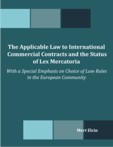Add abstract
Want to add your dissertation abstract to this database? It only takes a minute!
Search abstract
Search for abstracts by subject, author or institution
Want to add your dissertation abstract to this database? It only takes a minute!
Search for abstracts by subject, author or institution
by Amy Conroy
| Institution: | University of Ottawa |
|---|---|
| Department: | |
| Degree: | |
| Year: | 2016 |
| Keywords: | Aboriginal Peoples; Canada's National DNA Data Bank; equality; critical race theory; DNA; genetic information; investigative technologies |
| Posted: | 2/5/2017 12:00:00 AM |
| Record ID: | 2089776 |
| Full text PDF: | http://hdl.handle.net/10393/34285 |
Canada established its National DNA Data Bank (NDDB) in 2000. Since that time, the NDDB has assisted in the solving of numerous criminal investigations. The NDDB has two indexes: the convicted offender index, which holds the identifiable DNA of persons convicted of designated crimes, and the anonymous crime scene index, which holds anonymous DNA collected from crime scenes. A match to a crime scene profile provides criminal investigators with extremely valuable evidence linking a suspect to a crime scene and the NDDB has been used to identify perpetrators in thousands of crimes in Canada. By limiting the identifiable DNA in the NDDB to convicted offenders, Canada has aimed to balance the crime-solving benefits of the data bank with competing rights issues, particularly the individual right to privacy. Some have encouraged expansions to the NDDB scheme in order to increase the number of crimes that can be resolved through the use of DNA evidence. One possible expansion is to introduce familial searching, a technique in DNA analysis that enables suspect identification based on the existence of a partial match between an identifiable DNA profile and an anonymous profile retrieved from the scene of a crime. Where closely matching profiles indicate that a close genetic relationship likely exists between the identifiable offender and an anonymous perpetrator, police will have a useful lead for follow-up and may be able to locate a suspect by testing the DNA of the identified offender’s close relatives. The use of familial searching is controversial. As a crime-solving tool, it has helped solve crimes in other jurisdictions in which it is currently used. At the same time, it introduces legal and ethical questions that have not been fully explored in Canada. One of the crucial questions is whether and to what extent familial searching may discriminate against Canada’s Aboriginal peoples, who suffer the effects of systemic bias in the criminal justice system generally and who are likely to be overrepresented in the NDDB. Applied in an inherently unequal system, familial searching would disproportionately impact Aboriginal peoples and perpetuate or possibly worsen this existing inequality. To help inform Canada’s decision about the use of familial searching as part of NDDB operations, this dissertation examines the issue from a Critical Race Theory perspective. It outlines the various ways in which familial searching would disproportionately impact Aboriginal peoples. The dissertation further examines international approaches to familial searching and evaluates the extent to which these policies protect against racial inequality concerns relating to the use of familial searching in each jurisdiction considered. It argues that Canada should prohibit familial searching of NDDB data in order to avoid a situation in which the technique would perpetuate or worsen systemic bias against Aboriginal peoples in the Canadian criminal justice system.
Want to add your dissertation abstract to this database? It only takes a minute!
Search for abstracts by subject, author or institution


|
Time for the Appeal Tribunal in Investment Arbitra...
Lessons from WTO and Transitioning to the New Era
|

|
Identifying Juvenile Firesetters
A Survey of the Operating Procedures, Risk Assessm...
|

|
Implicity of Electronic Contract Formation
With Reference to Email and Website
|

|
Prisons in the Neoliberal Era
Class and Symbolic Dimensions
|

|
The Applicable Law to International Commercial Con...
With a Special Emphasis on Choice of Law Rules in ...
|

|
Incapacitating the Innocent
An Investigation of Legal and Extralegal Factors A...
|

|
Reasons for Disclosure in the Physician-Patient Re...
How Physician Conduct and Reimbursement Methodolog...
|

|
The Contribution of Natural Law Theory to Moral an...
|